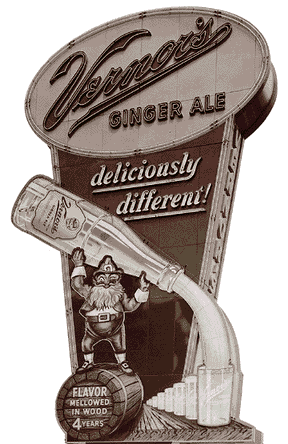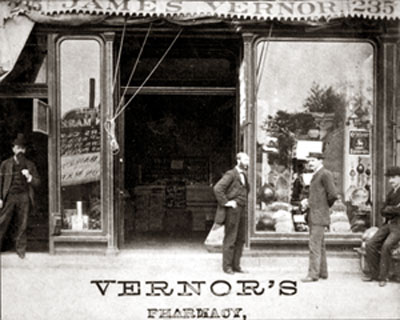This cache is a dedication to one of Americas oldest surviving soft-drinks:
Vernors Ginger Ale, a "Detroit Original".
Over 140 years ago, James Vernor served the first glass of Vernor's in his pharmacy at 235 Woodward Avenue...and began a legend in the soft-drink business.
The second bottling plant for Vernors was nearby the location of this cache and ran production of Vernors Ginger Ale from the 1950's through the mid 1980's.

Close-up of the Sign that was nearby in front of the bottling plant.
James Vernor was the creator/inventor of Vernors Ginger Ale and was born in Albany, NY. He moved to Detroit with his parents where he got a job at a drug store (Higby & Stern's) where he learned the business and became a pharmacist after being a clerk at the store.
In the late 1850's to early 1860's, a golden colored ginger ale was being imported from Ireland and was becoming quite popular throughout the United States. Experimenting with flavors, he endeavored to duplicate the popular ginger ale imported from Dublin. James Vernor began experimenting with different mixtures of ‘fizz water’ in the pharmacy and placed the contents in a wooden keg and stored it in the basement.
In 1862, James enlisted in the Fourth Michigan Cavalry as a Hospital Steward and proving to be adept at military sciences, was eventually promoted to Second Lieutenant, a position which he held until the end of the Civil War.
Once he had returned home from the War, he opened his own pharmacy at the corner of Woodward and Clifford in Downtown Detroit. At that time, he also opened the wooden keg that held his "concoction" for the previous four years. What he found in the keg after the war was not a “drink,” but an extract he could use in preparing a drink. It had a strange but wonderful taste and was proclaimed to be "deliciously different". Vernors Ginger Ale was born.

Front of the Drugstore at Woodward and Clifford.
James would go on to marry Emily Walker Smith in 1873 and the couple would soon have a son whom they named James Vernor II. From 1866 to 1896, Mr. Vernor would offer his ginger ale to his drug stores soda fountain patrons (most good drug stores had a soda fountain) but, Vernor’s Ginger Ale was not an instant success, as you might think, at least not on a large scale. In fact, it would not be until 1896 that enough business was being generated from the sale of ginger ale that Mr. Vernor was able to close his drug store and open a small plant at the foot of Woodward Avenue just a few doors down from his old drug store. It was here that Mr. Vernor, along with his nineteen-year-old son, James Vernor II, (the companies only employee) blended, aged, bottled, and distributed Vernor’s Ginger Ale. The Ginger Ale had to be aged for four years before it would ever be used to produce the soft drink. This process of aging in oak would continue until at least the 1980’s, and quite possibly is still being done today to age the extract used for the current Vernors product.
After 1896, Vernor’s Ginger Ale would grow by leaps and bounds and would become ginger ale that all others were judged by. Most bottlers had some type of specialty product that differentiated them from their competitors (like Cherry Nip, or Dr. Flints Julep), but they all went head to head with their ginger ales. For Vernors to dominate the market the way that he did was a huge deal and the name
James Vernor became synonymous with ginger ale. In fact, a publisher of a soda fountain formula guide even included a ginger ale formula in his guide that used Mr. Vernor's extract.
 Vernor's delivery trucks line up outside the newly expanded plant on Woodward in this 1915 photo.
Vernor's delivery trucks line up outside the newly expanded plant on Woodward in this 1915 photo.
After 1920, things changed for the consuming public and Prohibition came-along. During this time, Americans were visiting illegal speakeasies in droves, and the cocktail was at the height of fashion.
Many soft drinks were used as a mix with alcohol, and there was even one specifically made to mix with alcohol. It was called "dry" ginger ale and was colorless, almost tasteless, and less sweet than golden ginger ale. During prohibition, dry ginger ale became immensely popular, and golden ginger ale quickly fell off in popularity, as all forms of ginger ale would become associated with liquor in the non-drinking public’s mind.
At the beginning of Prohibition, there were many producers of ginger ale. Afterwards, Vernor's was one of the few golden ginger ales to survive. While other golden ginger ales where losing sales in dramatic numbers, Vernors was growing by leaps and bounds and even started selling their extract to other bottlers.
 A "Ghost Ad" from a Westside Detroit building wall.
A "Ghost Ad" from a Westside Detroit building wall.
In his lifetime, James Vernor was also known for being a member of the Michigan Board of Pharmacy for eight years and helped to pass the first pharmacy law. James also served on the Detroit City Council for 25 years and on many civic and philanthropic organizations.
Unfortunately, in 1929, James Vernor, Sr. (the founder and creator) passed away at the age of at 84 from bronchial pneumonia and influenza. His son continued the legacy of Vernors and would head the company until 1952 when he would then retire. At that time, Mr. Vernor’s nephew, J. Vernor Davis, was appointed president. James Vernor II passed away shortly after he retired.
J. Vernor Davis did an excellent job in running the company, resulting in huge sales. Things were going so well that in 1966, a group of investors purchased the soft drink company. However, without any family-heirs or namesakes running the company, it did not do as well and would later be sold to a consumer products company in 1971.
 Water Filters at the Woodward Plant
Water Filters at the Woodward Plant
One of the favorite activities of the general public was to watch their favorite drink being produced through the glass windows of the Woodward Plant.
It would be a few short years later (1979) that the company would be sold to another company and would end bottling operations at the Detroit plant in 1985.
In 1987 they brand would again be sold to another company, and through another aquisition or two, the eventual owner would be the same company that produces Dr. Pepper and 7up soft drinks.
A number of slogans have been associated with Vernors over the years. Advertising in the early 1900s used the slogan "Detroit's Drink". According to its trademark application, it began using the slogan "Deliciously Different" in 1921. The labels formerly read "Aged 4 years in wood", which was changed some years ago to "Flavor aged in oak barrels", again in 1996 to "Barrel Aged, Bold Taste" and currently notes "Barrel Aged 3 Years - Bold Taste".
 The aging room: A Vernor's worker checks a barrel of ginger ale in the plant's aging room.
The aging room: A Vernor's worker checks a barrel of ginger ale in the plant's aging room.
The apostrophe in the name "Vernor's" was dropped in the late 1950s. For a time in the mid-1980s Vernors used the slogan "It's what we drink around here" in its advertising campaigns.
For most of its history, Vernors was a regional product. Initially Vernor sold franchises throughout Michigan and in major regional cities such as Toledo, Cleveland and Buffalo. It would later be expanded in other regions when the company would start distributing the brand elsewhere.
Vernors is highly carbonated and has been regarded as a remedy for stomach-aches and upsets. Whether hot, warm, or cold, it seemed to work well for many folks that swear by it. Ginger is thought to be the active ingredient in the remedy.
It has also been used as a main ingredient in a refreshment-favorite of many Detroiters: the Boston Cooler.
Boston Cooler: YUM!
A Boston Cooler is an Ice cream soda variant typically composed of Vernors and vanilla ice cream blended together similar to a milk shake. However, in other parts of the country, different combinations of ingredients are also known as a Boston Cooler. The names origins remain a mystery and It appears to have no connection to Boston, Massachusetts, where the drink is unknown. One popular theory is that it named after Detroit's Boston Boulevard, the main thoroughfare of the Boston-Edison Historic District, said to be, in such accounts, a fashionable neighborhood at the time located a short distance from James Vernor's drugstore. Boston Boulevard, however, did not exist at the time.
The streets and subdivision that became the Boston-Edison neighborhood, approximately five miles from Vernors' drugstore, were not platted nor incorporated into the city until 1891, and its first homes not constructed until 1905, nine years after Vernor closed his drugstore.
 Woody the Mascot
Woody the Mascot
There has even been a Mascot for Vernors named "Woody". The mascot was used from the turn of the century until 1987, when it was dropped by the owner of the brand at the time in favor of new packaging, but had returned to the packaging by the 2000s.
For many Detroiters, the Vernors Plant on Woodward was a landmark that everyone loved and was part of Detroit History. This definitely was, a "Detroit Original".
This cache is dedicated to things like this that no matter how much the times or the area change, the memories will last a lifetime.